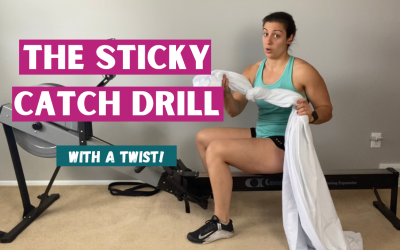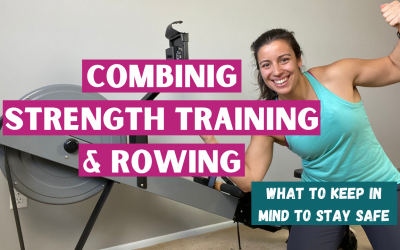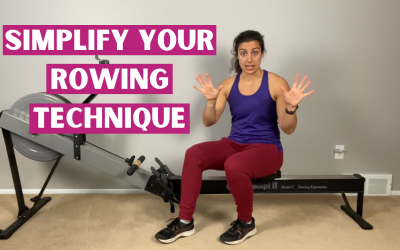Getting Body Swing in Your Rowing
When you watch yourself row, do you only use your legs and arms? If your stroke looks like that, you might be sitting up tall, but you’ve noticed that you don’t really have a body swing. You might see other people row where they’re leaning forward and then they’re leaning back in their stroke. With your stroke, you seem to just stay up tall and not move that body forward and backward.
Having that body swing in your rowing stroke is super important. 30% of the power comes from that body swing in your rowing stroke. So, if you’re missing out on it, that’s 30% of the power you could have! Incorporating this body swing is going to help you get faster splits, get more power into your stroke, and help your technique and efficiency. In this post (and the video above) I’m going to explain to you what that body swing should look like and some tips to help you work on it.
What It Looks Like
What should your body swing look like? You want that body swing to be from 11 o’clock to 1 o’clock. Now, what do I mean by that? Where is this clock? Imagine there’s a clock face on the side of you. You want that body swing to be back and forth from 11 o’clock to 1 o’clock. You don’t want to be leaning back too much or reaching so far forward that you’re at 2 o’clock or 10 o’clock. If you want to practice that body swing, feel free to come back and watch the video above to follow along and practice.
In that body swing, you want to pivot from the hips. If you’re having a trouble staying up tall (not hunching forward), shift those butt cheeks back to get those sit bones onto the seat. This will help you sit up a bit taller. Start by practicing that body swing from 11 to 1, keeping that chest up. As you rock forward, you don’t want to rock down. Ideally your shoulders are down and relaxed with your chest up maintaining good posture.
When to Swing
Now that you know the right position, it’s just as important to make sure you’re doing it at the right time. You’ll need to split it up on the recovery versus the drive. On the recovery, you want that body swing to happen after the arms come out, but before the knees bend. To simplify that, think about getting that handle out past the knees before you come up to the front of the stroke. So, you pivot forward, then your knees come up.
You don’t want to lean too far forward, whether that’s at the initial hinge forward or father up at the catch. It’s important that you don’t try to get extra reach and go to two o’clock at that catch. As much as you want to get more reach, you need to stick to that 1 o’clock position all the way into that catch.
On the drive, you want to swing that body back after those legs are down. First the legs to drive down, then body swings open, then you pull with the arms. Thinking about the drive: push with the legs, then swing while sitting up nice and tall. You don’t want to have too much extra lay back at the finish.
Common Errors & Drills
The first common error you’ll see in your stroke is that your knees may come up early. You may start to bend the knees when you’re at the noon position and finish the rock forward when you’re at the catch. What’s better is that you want to hit that 1 o’clock position before those knees bend. Once your shoulders are set at the 1 o’clock position, the only thing moving in and out of that catch are your knees coming up then driving right back down. This is the most common error I see on the recovery.
On the drive, a common error is leaning back at the catch, instead of driving those legs down first. This will happen when you’re focusing too much on pulling with the handle. It’s easy to think that leaning back will give you a better drive to the back. However, now you’re missing out on your big muscle groups. You’ll get the most power from using your legs, and that’s important. At the start of the drive, you want to keep your shoulders in front of your hips while the legs drive down. Only after that do you swing your body open.
There are a couple drills that can help you with the body swing. I like to use the pick drill to practice the body swing on the recovery. You start with arms only, then arms and body, and then arms, body, legs for full strokes. For working on the drive, I like to use the reverse pick drill. You start with leg only, then legs and body, and then full strokes. Those are a couple drills that you can do to practice that body swing and check that you’re doing it correctly.
Flexibility Tips
If you’re having trouble getting rocked forward into the right position, it could have to do with how you’re sitting on the seat. I mentioned earlier about getting those sit bones into the seat. If you’ve already tried that, you could be lacking some hamstring flexibility. As you rock forward, you will mostly likely feel those hamstrings stretch, and that’s okay.
If you need a loosen them up a bit to help you get that body rock forward, I do have a free stretching guide that you can check out (below).
Recap
I talked about that body swing being from 11 to 1 o’clock on the recovery, focusing on getting those arms out and body over before the knees bend. In other terms, get the handle past the knees before the knees bend. Then on the drive, you want those legs to be finished driving down and then that body opens.
If you liked the tips that you saw in the video or read in this post, feel free to subscribe to my YouTube channel! You can also subscribe to my email list by downloading the free stretching guide below.
The Sticky Catch Drill – with a twist!
The sticky catch drill is a great drill to feel the connection at the catch in your rowing stroke. And I have a different way of doing it that you may have never seen before. Most of the time, for the sticky catch drill, you can use a strap or something very sturdy...
How to Combine Strength Training and Indoor Rowing Workouts
If you want to up your rowing game with some strength training, then this is the post for you. After purchasing a strength program from a coach, these are some things you want to consider when you're combining your strength and rowing workouts. I'll throw in this...
Simplify Your Rowing Stroke
When you're just starting to learn how to row, it can be overwhelming watching technique videos, especially if it's a follow along drill or follow along workout where the coach is giving a lot of cues. Examples of cues are chest up, shoulders down, arms out then body...



